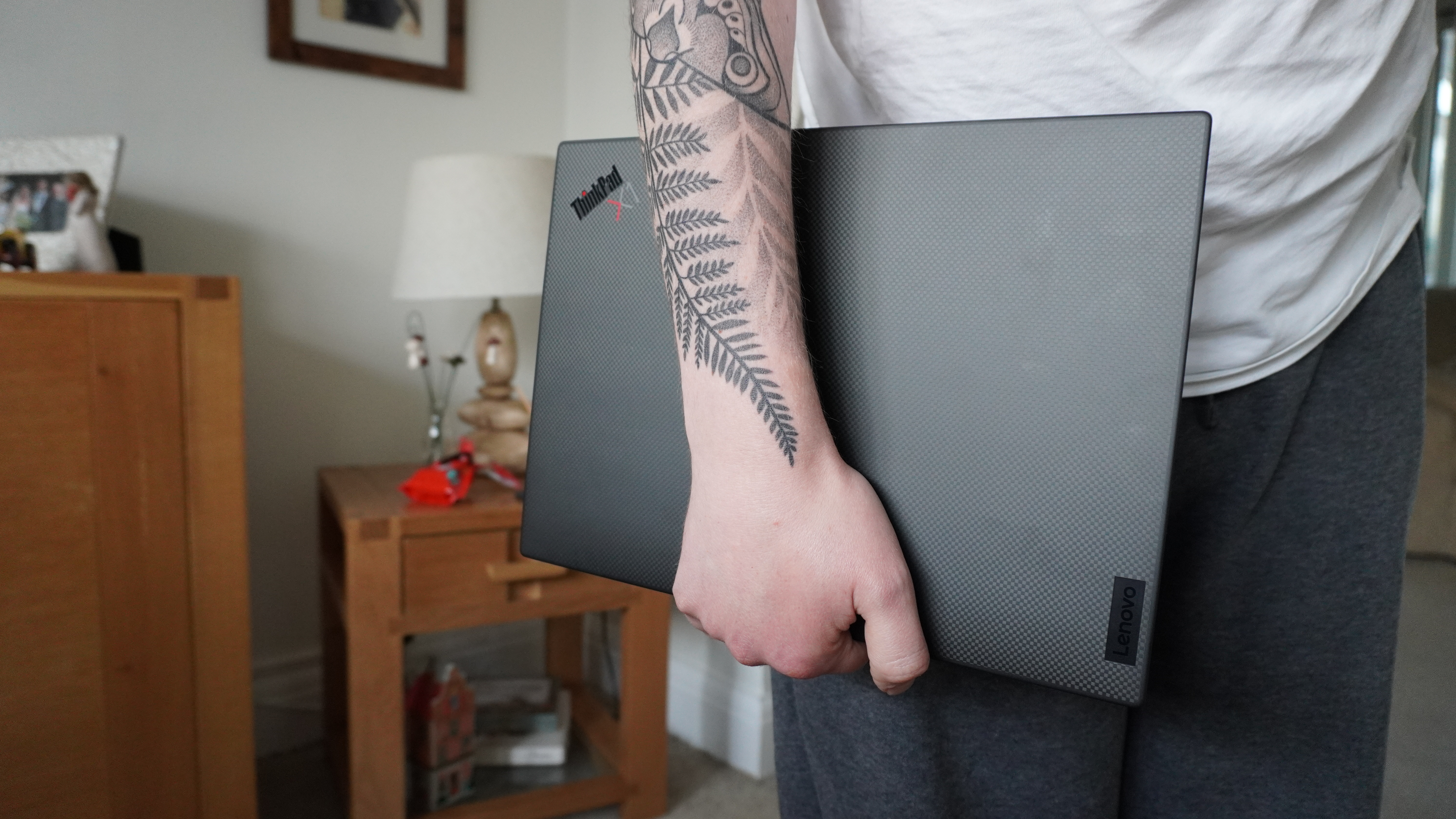Laptop Mag Verdict
The Lenovo ThinkPad X1 Carbon (Gen 10) continues to be one of the best business laptops you can buy right now — thanks to its super slim design, fantastic keyboard ergonomics, and speedy performance. But with a slower SSD and battery life taking a bit of a backseat, are we seeing the theoretical ceiling of what can be reached? I hope not.
Pros
- +
Impressively sleek, lightweight design
- +
Bright and vivid display
- +
Surprisingly strong speakers
- +
Incredible keyboard
- +
Decent 12th Gen Intel performance
Cons
- -
Slower SSD speed
- -
Weaker battery life
- -
Slightly cramped touchpad
Why you can trust Laptop Mag
For the past two generations, the Lenovo ThinkPad X1 Carbon has earned our rare 5-star rating. So what’s happened here, then?
Not to say this isn’t a belter of a working machine. In fact, I can safely say that it still deserves to be high up on our best business laptops list. You get that same great utilitarian aesthetic and durable chassis, with important upgrades to the internals, display, and webcam.
But as you’ll learn, with sticking to the same frame and cramming it with more, there are some drawbacks that stop the 10th generation version of the X1 Carbon from hitting full marks.
Lenovo ThinkPad X1 Carbon (Gen 10) price and availability
The 10th Gen ThinkPad X1 Carbon starts at $1,397, with the model we tested weighing in at $1,564. Again, these are supposedly the discounted prices on Lenovo’s website, but with a notorious history of inflating original retail prices, this lower number is what you should actually expect to pay.
In comparison, you can snag a similarly-specced M2 MacBook Air for $1,699, and the Dell XPS 13 Plus for $1,649 (currently discounted to the impressive price of $999).
But there’s another looming specter in the form of the Gen 11 Carbon, which is available to buy at $1,833 and packs the latest 13th Gen Intel chipsets. While we don’t have a review of this brand new unit just yet, we can start to ask a couple of questions.
Is it worth the additional investment for the latest and greatest? Or can you get just as speedy of a working experience and save yourself some money at the same time with Gen 10?
Sign up to receive The Snapshot, a free special dispatch from Laptop Mag, in your inbox.
Lenovo ThinkPad X1 Carbon (Gen 10) design

Nothing new to report when it comes to the X1 Carbon’s design. Lenovo found a durable, sleek aesthetic the people love, and the company is leaning into it. From the matte-black surfaces and subtly lit “i” in the ThinkPad logo on the lid, to the carbon fiber detailing and stealthy aesthetic, it still looks marvelously modern.
Stereo speakers still flank each side of the keyboard, and the power button keeps its place on the right edge – just below the same single bar-style hinge that gives the whole frame a nice, confident sturdiness.
And let’s not forget how surprisingly thin and light this laptop is. You can pick it up single-handedly with the greatest of ease, and the weight is evenly distributed across the width of the whole system.
As you can see, the svelte X1 Carbon is not quite as small as the likes of the MacBook Air and XPS 13 Plus, but it’s far lighter in construction!
Looking past the numbers, you’re getting a seriously sleek, durable system that is a cinch to carry around and a real subtle eye-catcher to bring out during a meeting.
Lenovo ThinkPad X1 Carbon (Gen 10) security & durability
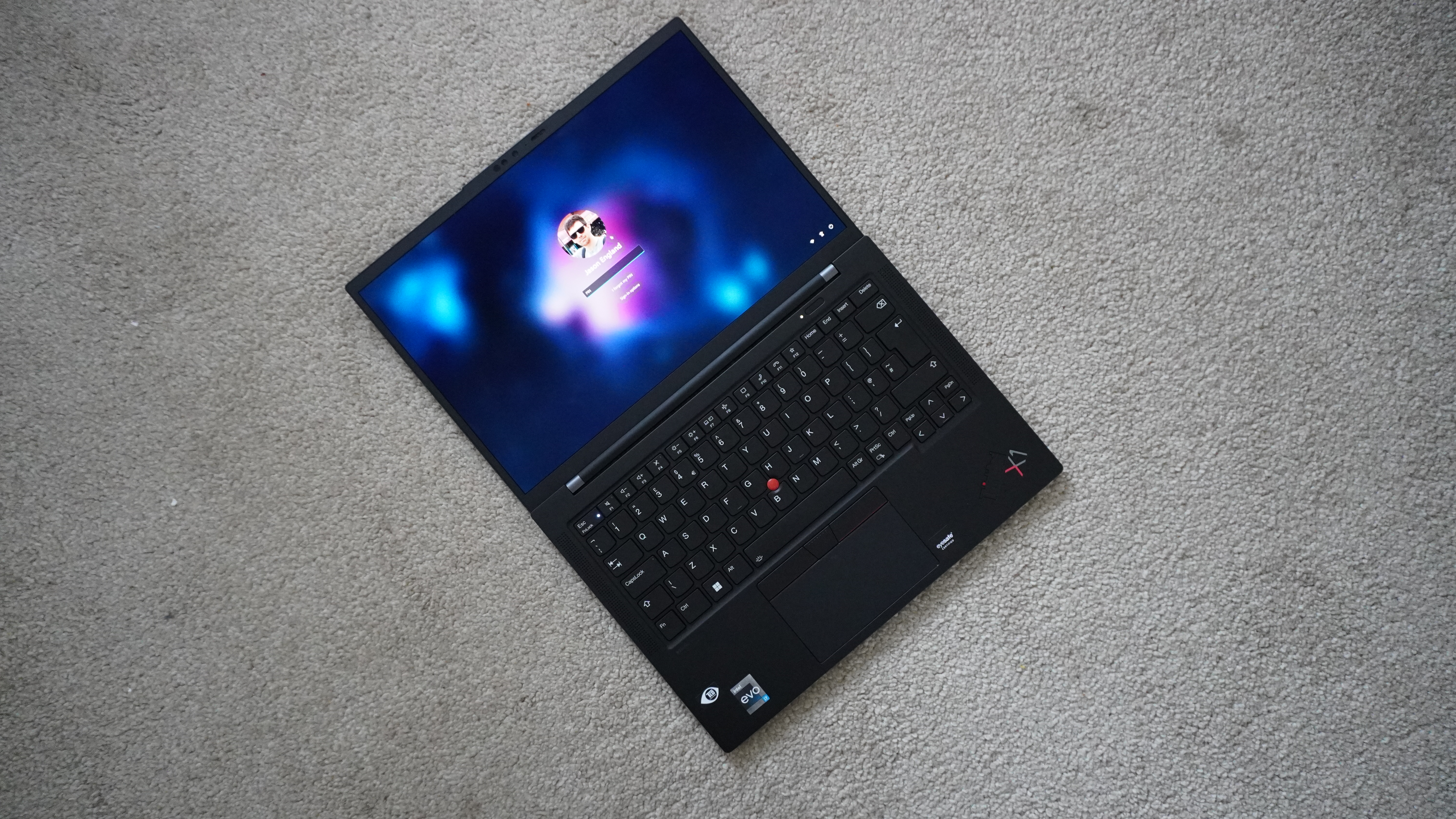
Just like the Gen 9, the X1 Carbon continues to pack all the modern security requirements for keeping any business-sensitive data locked down for your eyes only.
This includes all the standard features like the Kensington lock slot, fingerprint reader on the power button, and the IR camera for facial recognition via Windows Hello. But beyond that, you’ll find a human presence detector (to automatically lock the laptop when you step away), a TPM 2.0 chip, and the option to turn on glance privacy alerts if the webcam catches someone peeking. This is miles ahead of what you will see on both the MacBook Air and XPS 13 Plus.
Plus, for those who are either more prone to be clumsy or want something that will survive even the most rugged environments, the X1 Carbon continues its record of passing a ton of military-grade durability tests, so you can be confident in its strength.
Lenovo ThinkPad X1 Carbon (Gen 10) ports
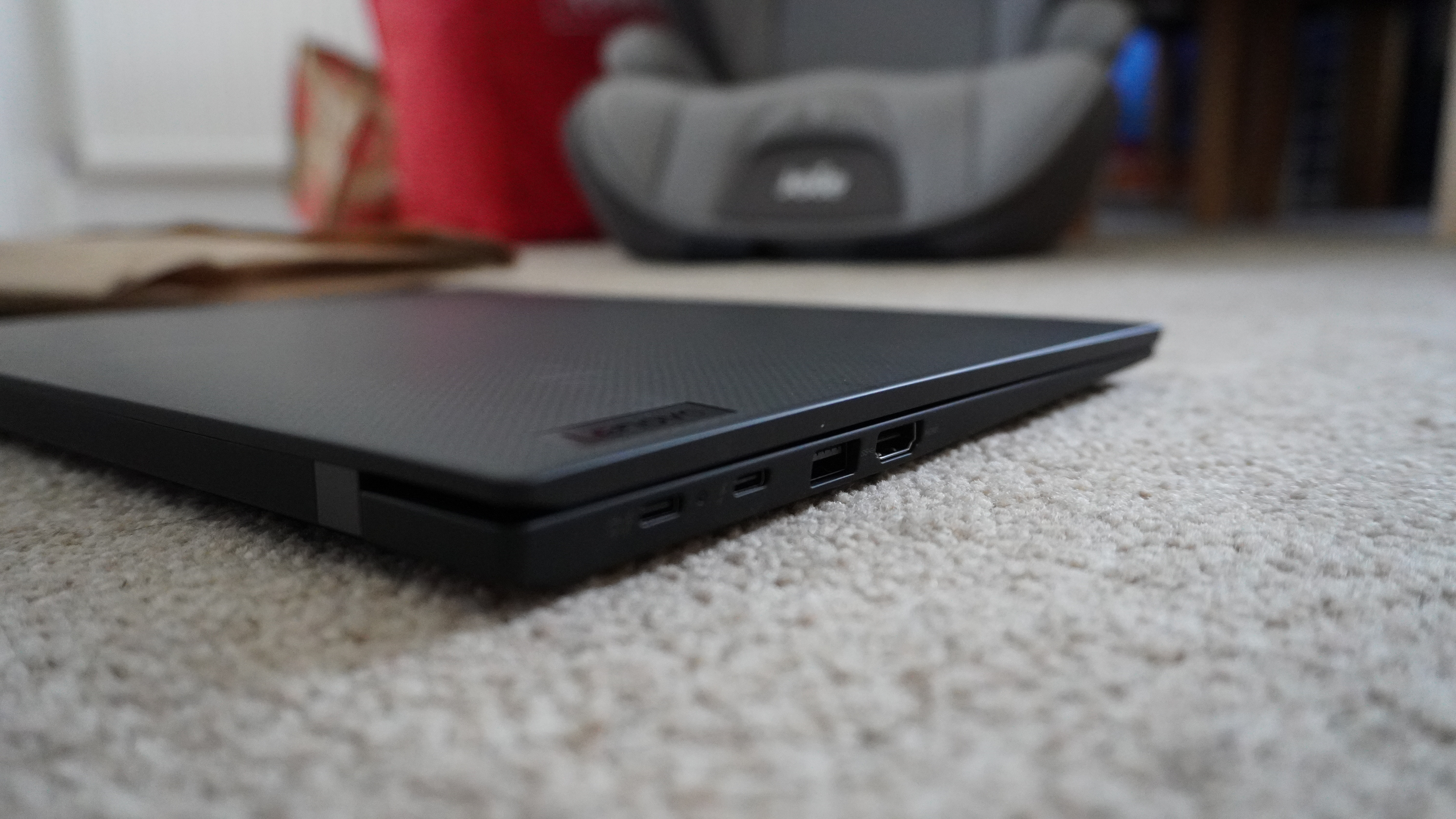
The port selection remains largely unchanged from Gen 9 — a USB 3.2 Type-A port, headphone jack, and a Kensington lock on the right, along with two Thunderbolt 4 ports, a second USB 3.2 Type-A, and HDMI 2.0.
One new addition is the SIM tray for mobile data, which is nice to have in terms of increasing versatility. But the lack of an SD card slot still hurts. If you’re in need of extra connectivity, the best docking stations will do the trick.
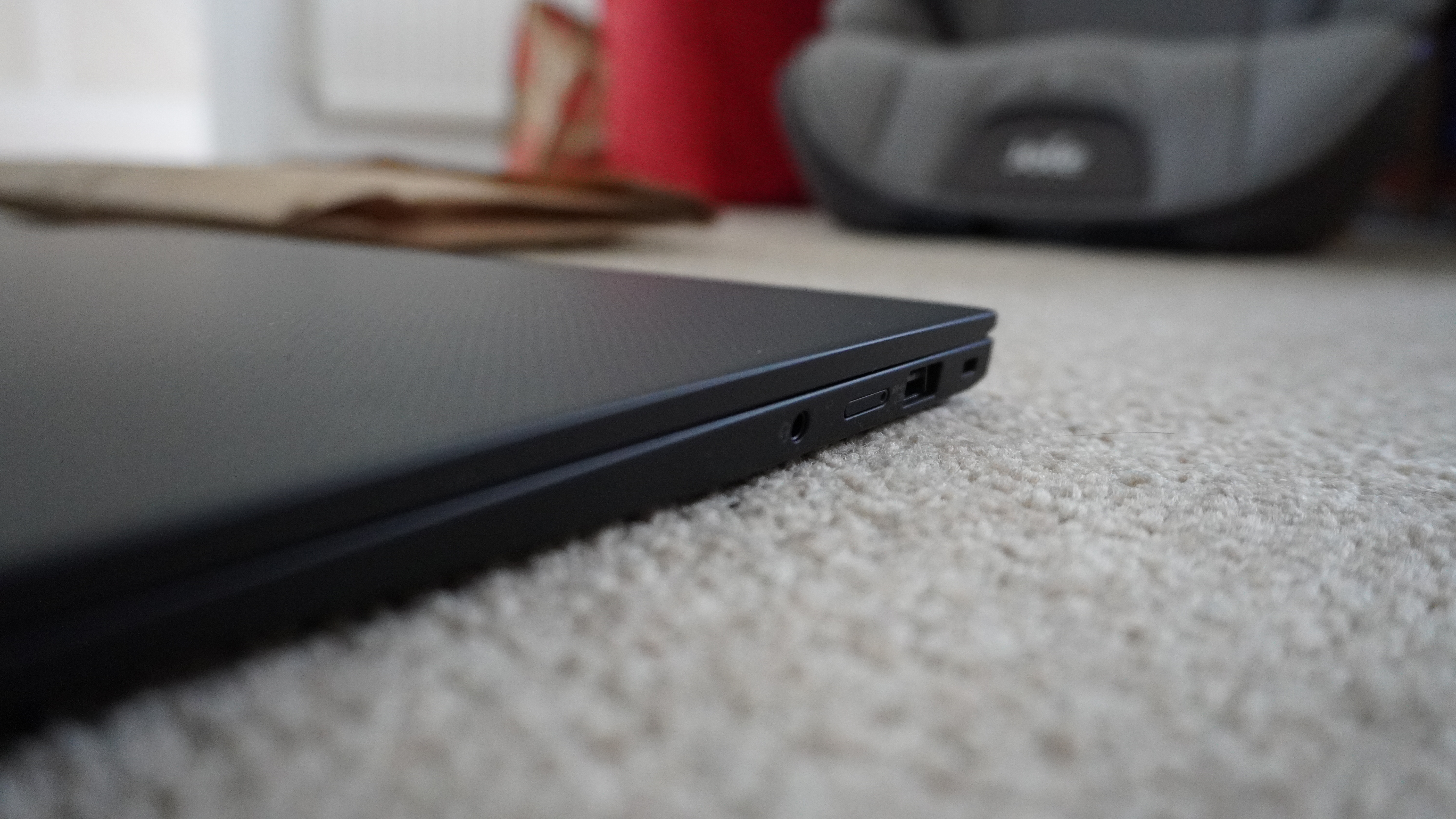
Lenovo ThinkPad X1 Carbon (Gen 10) display
When it comes to Lenovo’s business-centric ThinkPad laptops, display brightness and color isn’t usually a strong point. But the X1 Carbon has some decent brightness and color to its 14-inch, IPS Eyesafe panel with a 1920 x 1200-pixel resolution and 16:10 aspect ratio.
Of course, the OLED panel in the XPS 13 Plus is miles ahead of both of them in terms of color reproduction, but the middle-of-the-road stats for the X1 make this a respectably bright screen, if not the most colorful.
Shows like the impressive Obi-Wan Kenobi reveal the lack of hue in warmer scenes, but do show off the contrast ratio in its darkest moments, while dealing with accurate tones in creative applications such as Photoshop is a joy that you will rarely see on screens of this size.

Oh, and with TÜV Rheinland Low Blue Light and Flicker Free certification, you can work on this minibeast late into the night with confidence that your eyes are being looked after.
Lenovo ThinkPad X1 Carbon (Gen 10) keyboard and touchpad
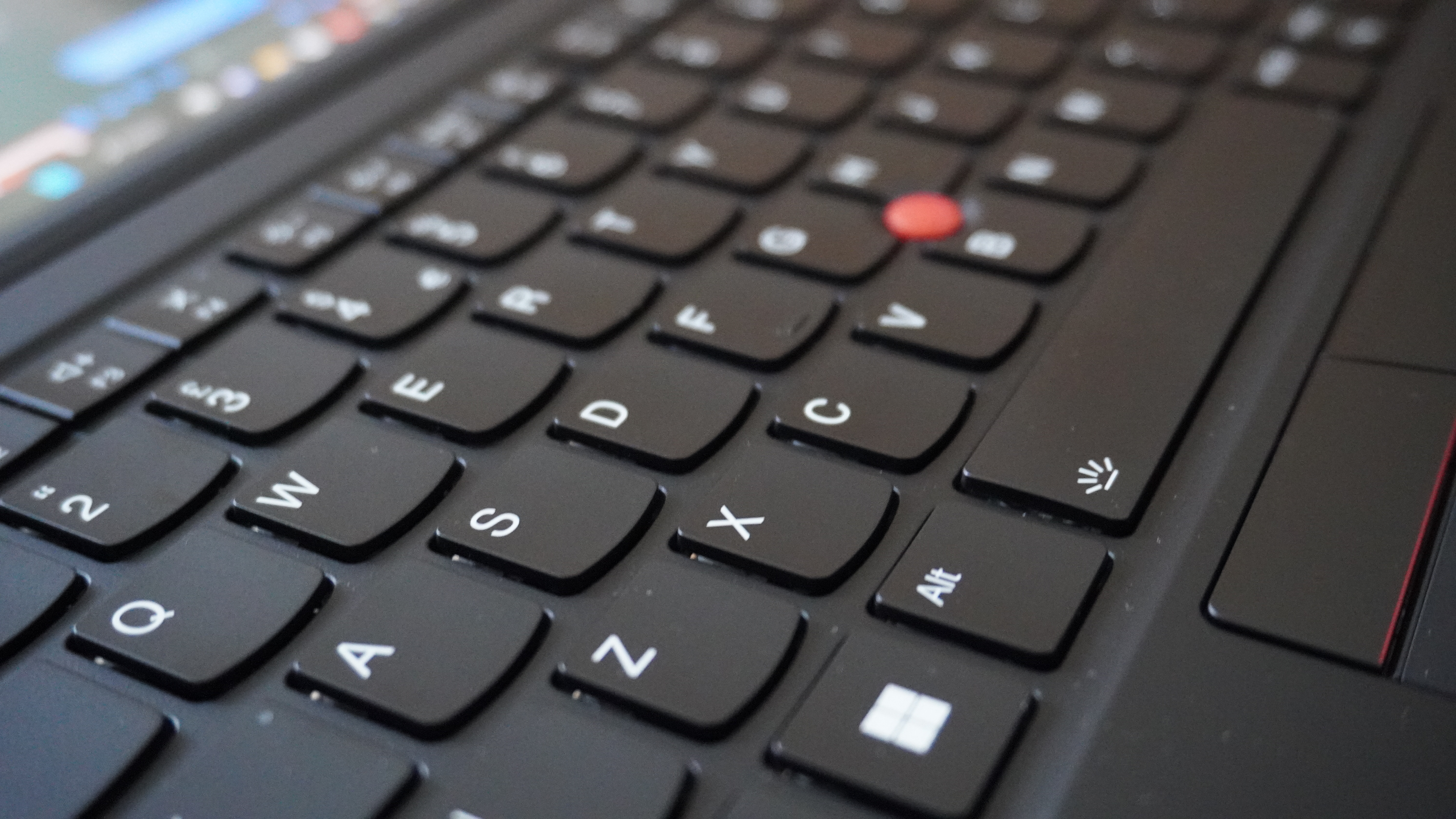
Lenovo’s love story between its ThinkPad keyboard and your fingers continues in the X1 Carbon, and trust me when I say you’ve bagged a 10 when it comes to an ergonomically sound typing experience.
Each keystroke feels supple and deliberate with generous travel and a soft-yet-tactile response , while the subtle dish envelopes each finger and makes it perfect for touch typing.
I tested the keyboard using the 10FastFingers.com typing assessment and I hit my fastest score of 90 words per minute. For context, I normally hit 83-85 wpm on a laptop keyboard, which emphasizes how fantastic this board is. Plus, backlighting is customizable and uniform without a single blip of extra brightness.
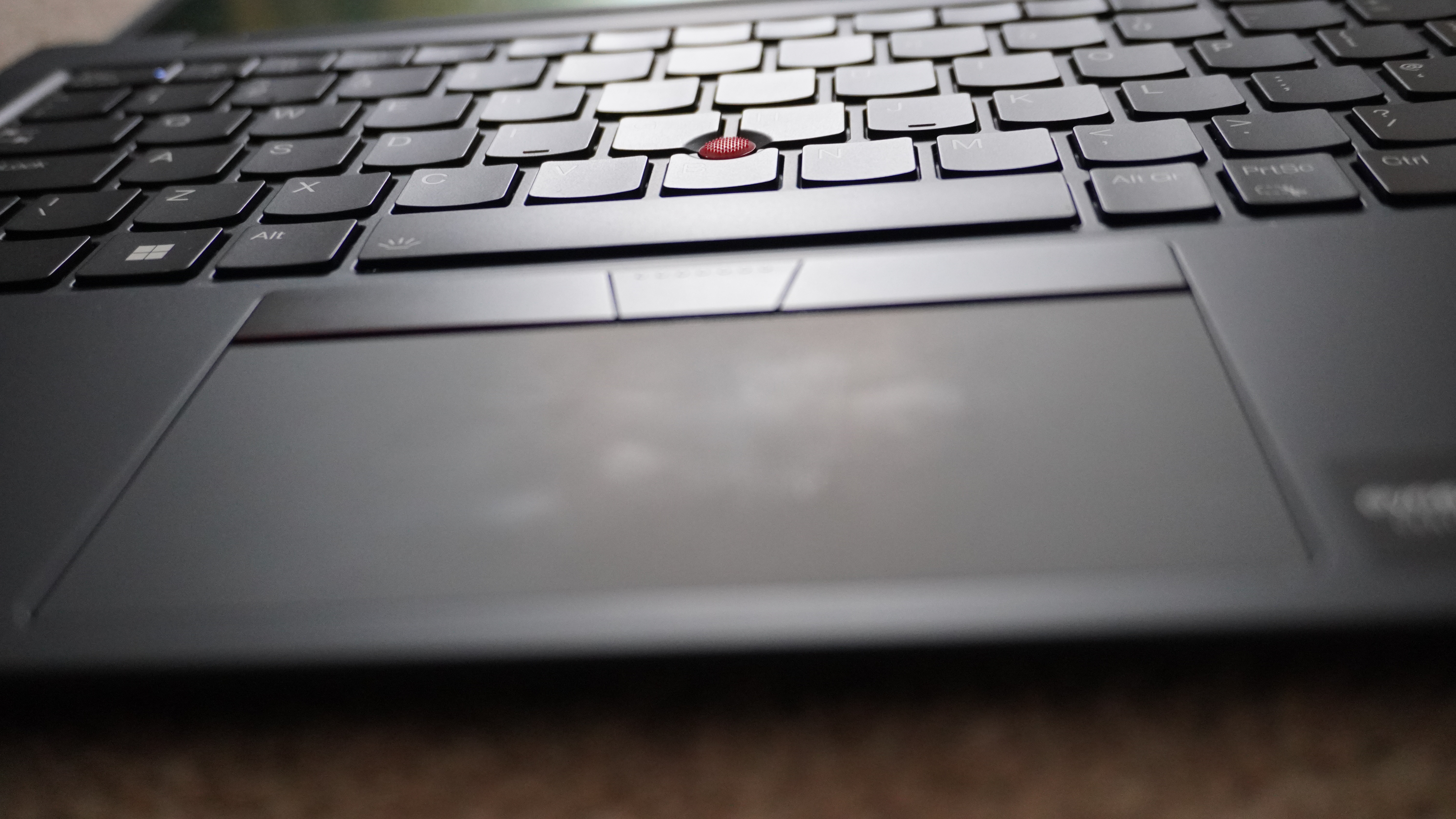
One downside is the slightly cramped touchpad. Don’t get me wrong, at 4.6-inches wide, there’s enough on the horizontal for smooth glides across the display (alongside all the Windows 11 multi-touch gestures you know and love). But the 2.3-inch vertical due to the mouse-click buttons for Lenovo’s staple TrackPoint (yep, still awkward for anyone under 30 to use), scrolling up and down feels a little restricted.
Lenovo ThinkPad X1 Carbon (Gen 10) audio
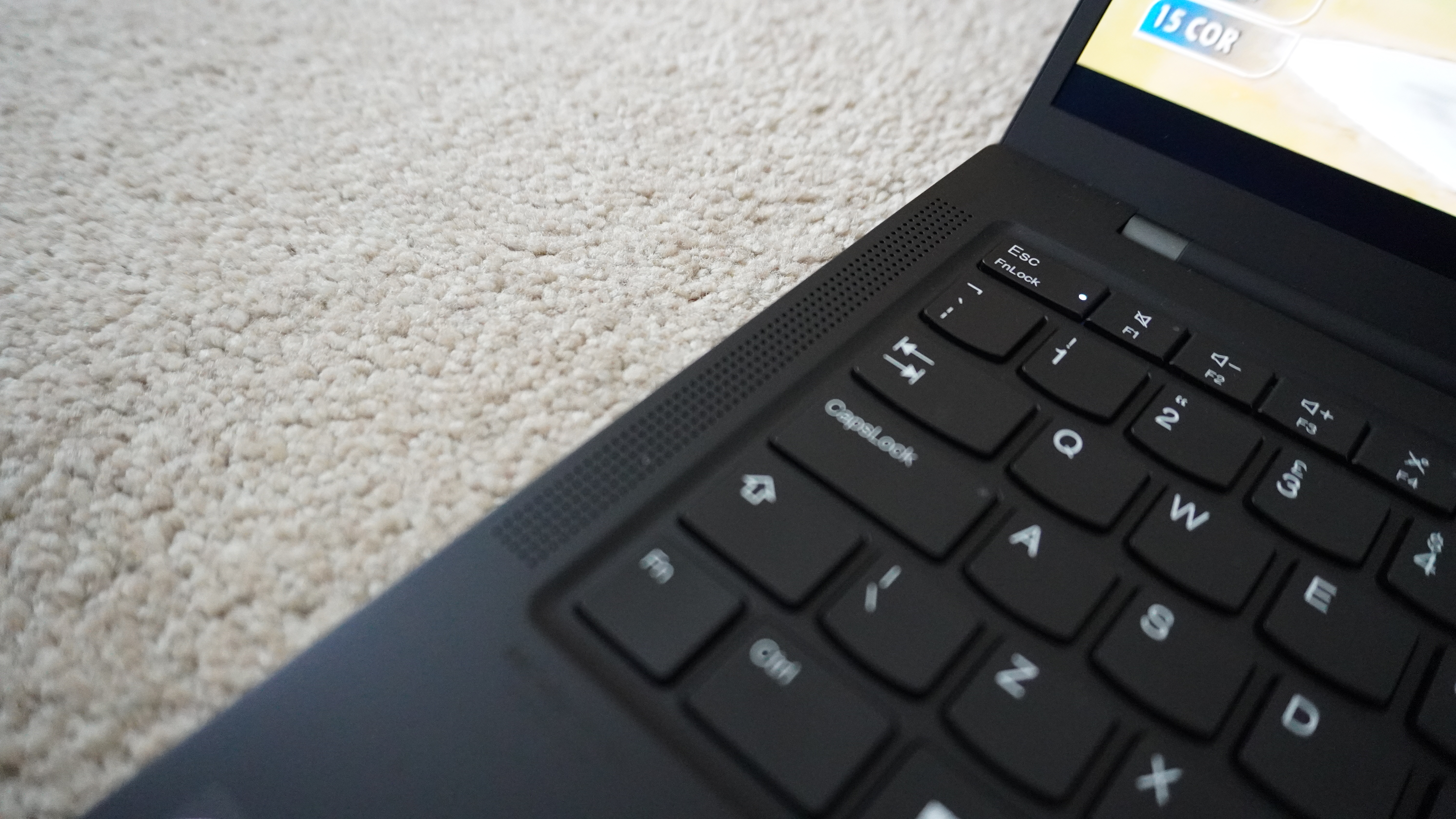
You’ve got a four-speaker setup, with two firing upwards on either side of the keyboard, and a second two just below on the underside — tuned with Dolby Atmos for clean audio at even top volume.
They even handled the intensity of The Ghost Inside’s album “Returners,” which offered a brightness to the all-out assault of furious vocals and chugging guitars with zero distortion, while managing to give a worthy bass punch to the thunderous percussion.
Oh, and for times when you want to listen to stuff in public, there is a 3.5mm headphone jack — something you’ll find on the MacBook Air too, but not the XPS 13 Plus.
Lenovo ThinkPad X1 Carbon (Gen 10) performance
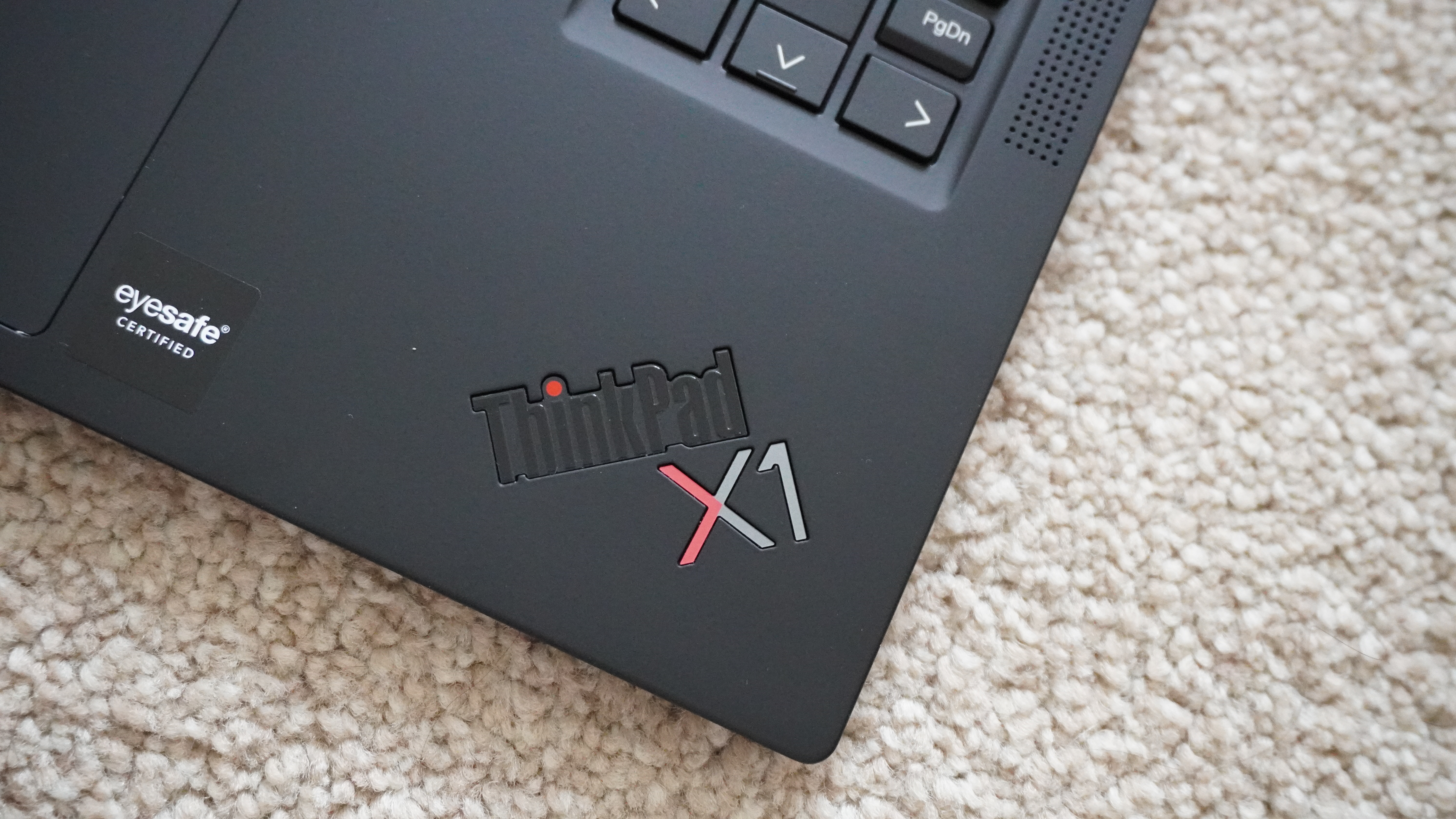
Under the hood is a 12th Gen Intel Core i7-1265U CPU with two performance cores and eight efficiency cores, 16GB LPDDR5 RAM (upgradeable to 32GB), and a 1TB PCIe Gen 4 SSD.
Of course, things have moved on slightly since the 12th generation, the efficiency-centric notebook CPU is turned down when compared to the Intel Core i7-1260p in the XPS 13 Plus, and nobody has quite managed to achieve that fine balance between power and efficiency that Apple’s M2 has.
However, in real world use, the X1 Carbon runs nice and smooth. I threw a lot at this machine — Two Point Campus running in the background as I edited a massive RAW picture in Photoshop, played multiple 1080p YouTube videos, and ran a couple benchmarks. Even under such pressure, touch responsiveness didn’t lag and the system kept running smoothly.
One standout issue here is the SSD speed and Handbrake transcoding — symptomatic of the 80/20 split between efficiency and performance cores, which leads to this big shortfall in the chip’s ability to deal with some more process-intensive tasks.
Lenovo ThinkPad X1 Carbon (Gen 10) graphics

One thing is obvious — the X1 Carbon is not built for gaming. This is definitely the laptop equivalent of a tight-fitting suit and posting cringe LinkedIn statuses about dedicating your life to hard work (as if a social life doesn’t exist).
However, so long as you keep your gaming casual and turn those graphics settings down, you can get away with some games at around 30 FPS like F1 Manager 2022 on low presets. That much is clear from the 3DMark and Sid Meier’s Civ 6 results.
Outside of gaming, the graphical capabilities mean you can edit high-resolution photos and edit a couple streams of 4K video without any dramatic slowdown. This clearly isn’t built with creative pros in mind, but at least there is some horsepower to deal with it.
Lenovo ThinkPad X1 Carbon (Gen 10) battery life
We absolutely adored the battery life of the Gen 9 — 15 hours and 39 minutes was well and truly the promised land. But Lenovo couldn't match that with the Gen 10, as you’re seeing five hours chopped off the top. Don’t get me wrong, that’s still usable for a day’s longevity, but the worry-free battery life is no more.
My day involves multiple Chrome tabs, Spotify and Slack running constantly, the occasional use of Photoshop, and some casual gaming on my lunch break (Uno is my current addiction). Starting at 9 a.m., I reached around 4 p.m. before needing to charge. If you’re economical with power over those long periods away from plug sockets, I’m sure you could get the full nine hours.
As you can see, the M2 MacBook Air continues to be an absolute champ in the small laptop battery life, but the Carbon does handily beat the XPS 13 Plus.
Lenovo ThinkPad X1 Carbon (Gen 10) webcam
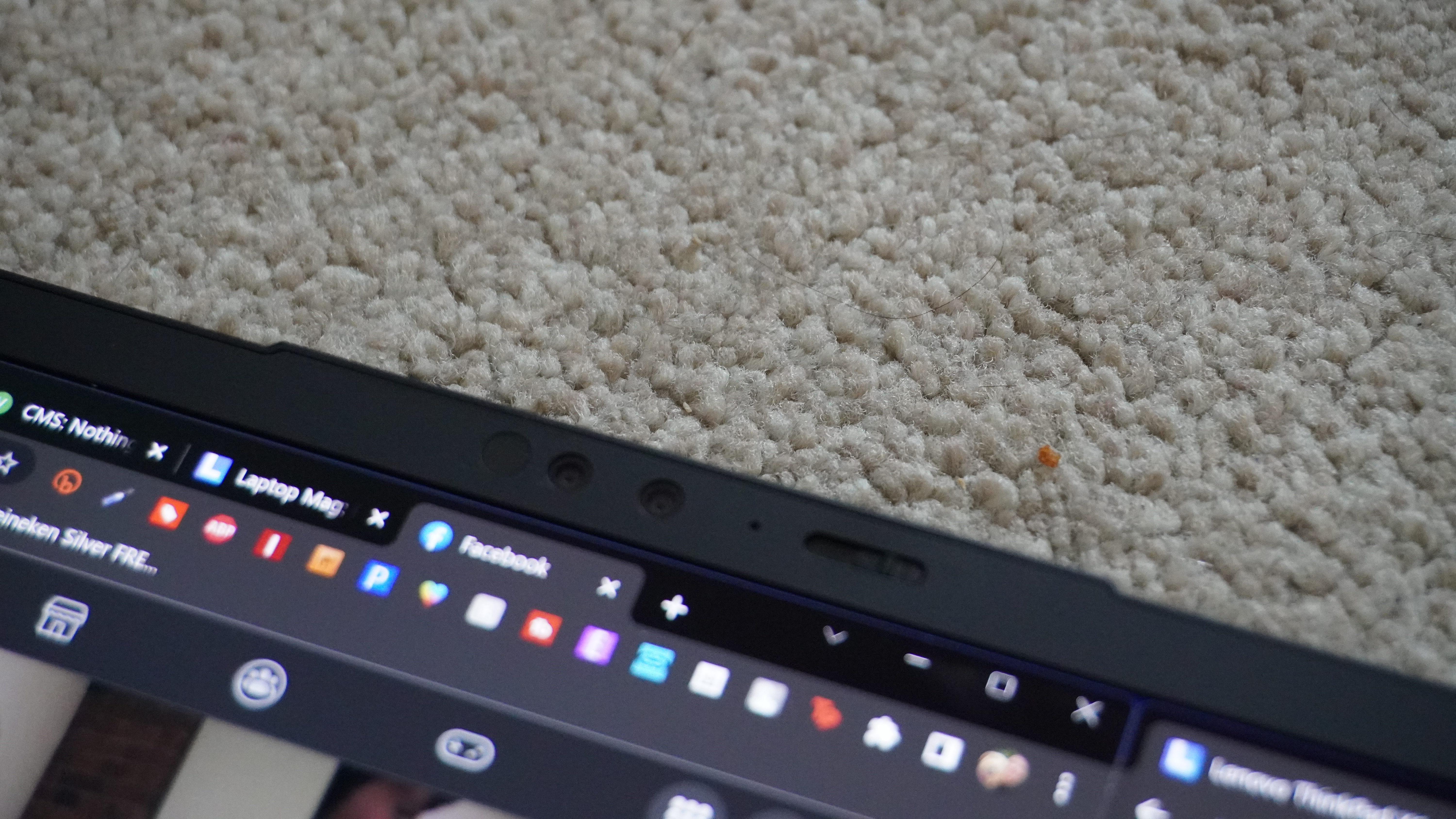
One fortunate upgrade is the webcam, which gets a sharper 1080p resolution and a slightly wider aperture for better lighting on captures. It’s still a little noisy when the sun goes down, but at least the picture is better than the potato you got on the Gen 9 — elevating it slightly above the PS2’s EyeToy.
Of course, there is a convenience factor here with Windows Hello support, which uses facial recognition to rapidly log you into the system via the IR camera.
Need better picture quality built in? I’d look towards the M2 MacBook Air, but you will always need to pick up an external webcam for the best possible capture.
Lenovo ThinkPad X1 Carbon (Gen 10) heat
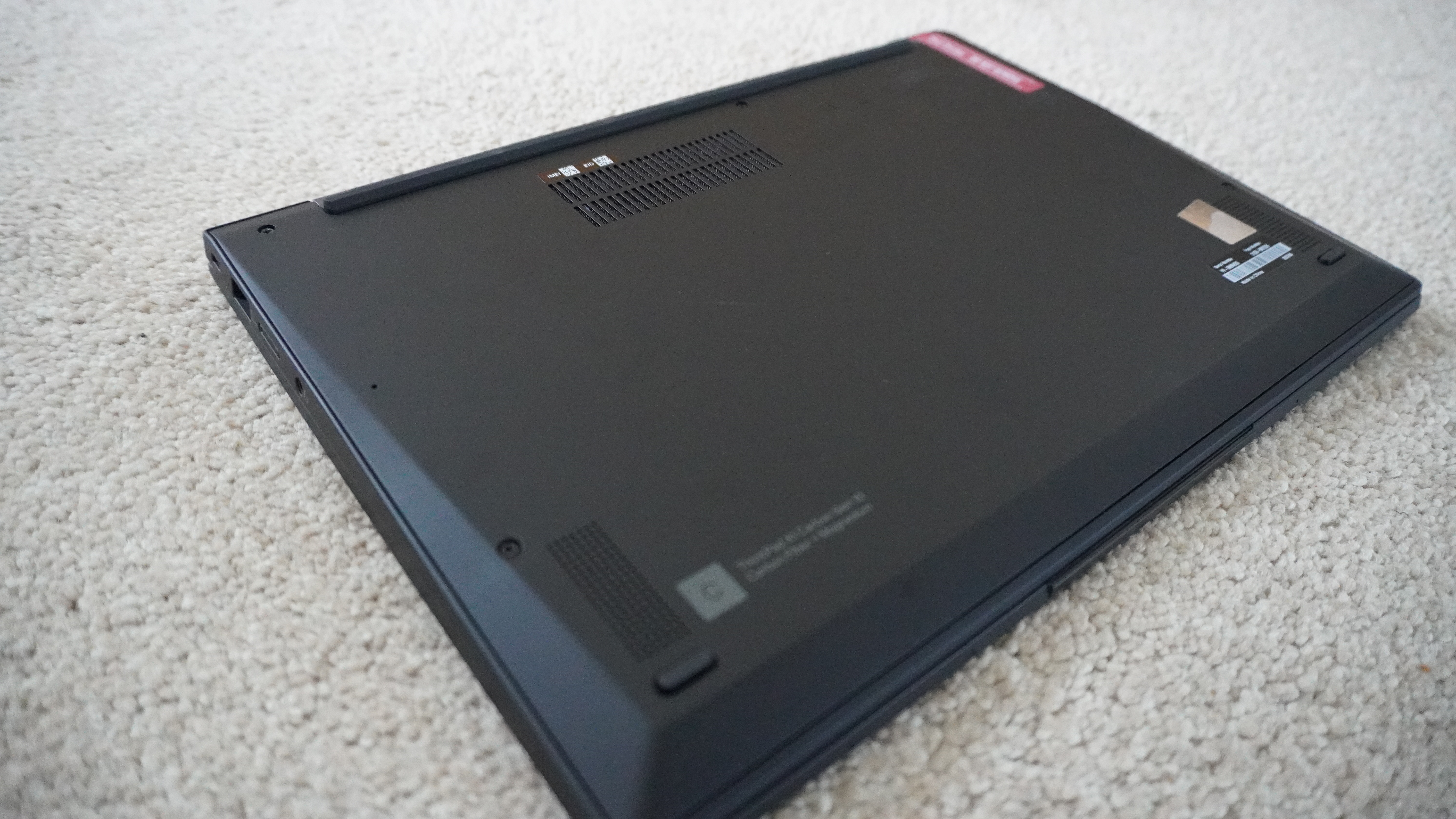
On the Nando’s spice scale (ask your British friends), I’d put this at about medium — some decent heat, but not overwhelmingly so as to make it uncomfortable.
Comparatively, the dark magic Apple cast with the MacBook Air means it remains untouched in terms of surface temperatures, but the XPS 13 Plus is the equivalent of eating a spicy daal. With venting on the bottom, the X1 Carbon’s system maintained its performance without any thermal throttling, but you can expect the fans to whir up quite loudly if you do!
Lenovo ThinkPad X1 Carbon (Gen 10) software and warranty

Much like all Lenovo ThinkPads, the Vantage app gives you a helping hand with a lot of things. You can customize your computer’s settings, check your warranty, and update your system. You can even perform hardware scans and configure your Wi-Fi security. Thankfully, Lenovo ties up all of its stuff in this one app.
The ThinkPad X1 Carbon comes with a one-year limited warranty. See how Lenovo performed on our Tech Support Showdown and Best and Worst Brands ranking.
Bottom line

When it comes to peak productivity, the ThinkPad X1 Carbon (Gen 10) continues its reign atop the mountain of business laptops. There are some decent performance and hardware gains over the mighty ninth generation that are sure to make this a zippy
Those improvements do come at a cost, such as a drop in battery life and increased heat. Not only that, but we’ve seen a slight slowdown in SSD speed, and thanks to sticking rigidly to its utilitarian frame of its predecessor, the touchpad feels a little cramped.
But while there are certainly some solid business alternatives if that’s the category you’re committed to, such as the HP Elite Dragonfly G3 (if you want that longer stamina), the X1 Carbon continues to be at the pinnacle for workers on the go.

Jason brought a decade of tech and gaming journalism experience to his role as a writer at Laptop Mag, and he is now the Managing Editor of Computing at Tom's Guide. He takes a particular interest in writing articles and creating videos about laptops, headphones and games. He has previously written for Kotaku, Stuff and BBC Science Focus. In his spare time, you'll find Jason looking for good dogs to pet or thinking about eating pizza if he isn't already.
